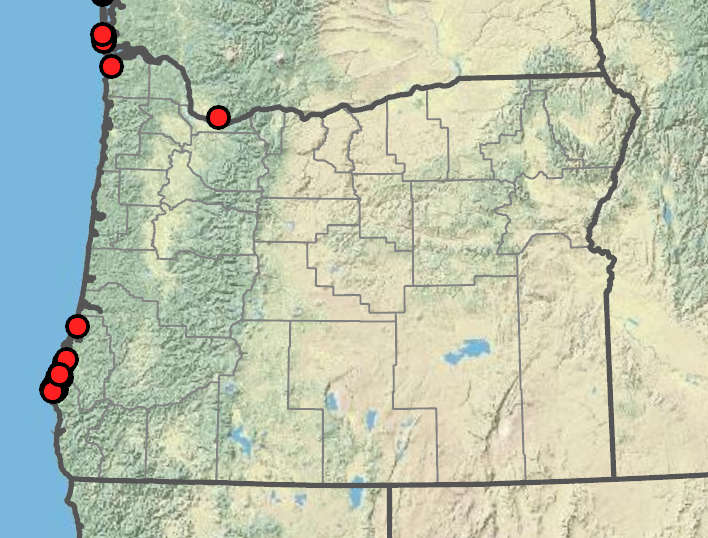Juncus tenuis
Juncus canadensis
path rush, poverty rush, slender rush
Canada rush, Canadian rush
thin and wiry;
blade flat and slightly inrolled, usually 1–8 mm on early season shoots; dirty white or translucent, scarious; acute or acuminate;
auricles soft and thin.
basal and cauline; round; hollow, septate, 1–2 mm wide;
auricles 1–1.2 mm.
cymes, usually small, 1–6 cm; individual flowers often longer than internodes;
bractlets subtending flowers usually acute (blunt).
panicles of 3–50 clusters; clusters 5–50-flowered, not obscured by inflorescence bract.
tepals 6, 3–4.1 mm, green to reddish;
tips acuminate;
stamens 6;
filaments 0.6–1.2 mm;
anthers usually 0.4–0.6(0.8)mm;
styles 0.1–0.3(0.5)mm.
tepals 6, green; reddish, or pale brown;
tips acuminate;
stamens 3;
filaments 0.8–1.5 mm;
anthers 0.3–0.5 mm;
styles 0.2–0.3 mm.
usually 2.5–3 mm; more than 75% the length of; and shorter than the tepals, pale brown;
apex usually blunt (acute), not crested, 1-chambered.
usually 0–1 mm longer than the tepals, dark brown, 1-chambered.
0.4–0.5 × 0.2–0.25 mm, apiculate.
narrowly ellipsoid to linear, 1.25–1.9 × 0.2–0.25 mm;
bodies 0.5– 0.8 mm; tails 0.3–0.5 mm, 0.5–1 times as long as seed body.
=40, 80.
=80.
Juncus tenuis
Juncus canadensis
Shores, swales, springs, dune hollows, wet woods, marshes, damp paths, ditches, cranberry farms, moist disturbed sites. 0–1800m. BW, Casc, CR, Est, Lava, Sisk, WV. CA, NV, ID, WA; throughout most of North America. Native.
Juncus tenuis is usually much smaller than Juncus anthelatus. The blunt unridged capsules separate J. tenuis from J. confusus, J. occidentalis, and J. trilocularis.
Shores, ponds, peatlands, disturbed sandy acidic wet ground, cranberry farms, ditches. 0–100 m. Est. WA; north to British Columbia; eastern North America; Europe, New Zealand. Exotic.
This species was introduced by cranberry agriculture and is spreading into natural wetlands. Some authors suggest rare flowers have 6 stamens.
Peter Zika
Peter Zika
- Local floras:
BC,
CA,
OR,
WA
- Local Web sites:
CalFlora,
CalPhotos,
Flora NW,
PNW Herbaria
WildflowerSearch
iNaturalist (observations)
USDA Plants Database
- LBJ Wildflower Center
- SEINet
- Plants of the World Online
- Encyclopedia of Life
- Wikipedia
- Google Image Search
- Local floras:
BC,
OR,
WA
- Local Web sites:
Flora NW,
PNW Herbaria
WildflowerSearch
iNaturalist (observations)
USDA Plants Database
- LBJ Wildflower Center
- SEINet
- Plants of the World Online
- Encyclopedia of Life
- Wikipedia
- Google Image Search


